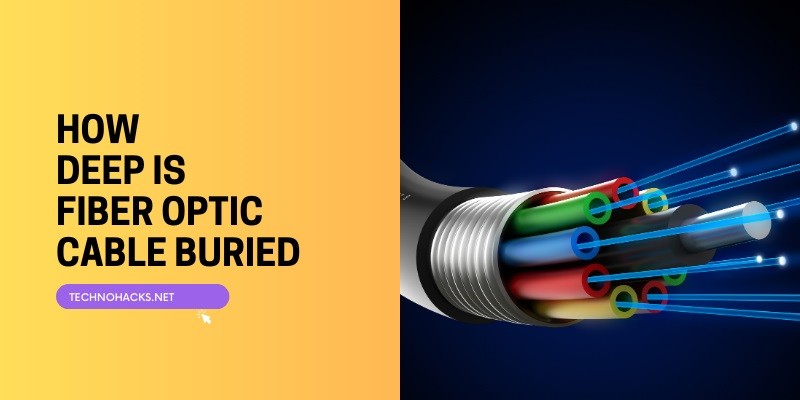Last Updated on May 5, 2025 by Jim C.
Fiber optic cables form the backbone of modern telecommunications and internet infrastructure, providing high-speed data transmission over long distances. One crucial aspect of installing these cables is determining the appropriate burial depth to ensure their protection and longevity. This article explores the factors influencing burial depth, standard practices, and considerations for different environments.
Standard Burial Depths
The typical burial depth for fiber optic cables ranges from 12 to 48 inches (30 to 122 cm) below ground level. However, the most common range is between 18 to 36 inches (45 to 90 cm). This depth range provides a balance between protection from external factors and accessibility for maintenance and repairs.
In urban areas, where the ground is frequently disturbed due to construction and other activities, fiber optic cables are often buried at the deeper end of the spectrum, typically between 36 and 48 inches (90 to 122 cm). In contrast, rural areas may see shallower burial depths, usually between 24 and 36 inches (60 to 90 cm).
It’s important to note that these depths are general guidelines, and the actual burial depth can vary based on several factors, including local regulations, environmental conditions, and specific project requirements.
Factors Affecting Burial Depth
Several key factors influence the decision on how deep to bury fiber optic cables:
- Soil Type: The composition of the soil plays a significant role in determining the optimal burial depth. Different soil types have varying load-bearing capacities and stability characteristics. In areas with poor geology or sunken soil, cables may need to be buried deeper to enhance their protection.
- Climate: Environmental conditions, particularly in regions with high humidity or frequent rainfall, may necessitate deeper burial to prevent groundwater intrusion. In areas prone to freezing, cables must be buried below the frost line to prevent damage from frost heaves.
- Local Regulations: Building codes and local regulations often specify minimum burial depth requirements for fiber optic cables. These regulations are designed to ensure the safety and longevity of the infrastructure while minimizing potential hazards to the public.
- Urban vs. Rural Settings: The level of human activity in an area significantly impacts burial depth decisions. Urban environments, with their frequent ground disturbances due to construction and utility work, often require deeper burial to protect cables from accidental damage.
- Proximity to Other Underground Facilities: The presence of other underground services, such as water pipes, gas lines, or electrical conduits, can affect how deep fiber optic cables can be safely installed.
- Type of Fiber Optic Cable: The specific characteristics of the cable being used can influence the required burial depth. Some cables are designed to withstand shallower placements, while others may require deeper burial for adequate protection.
Installation Methods
The method used to install fiber optic cables can also impact the burial depth. Common installation techniques include:
- Trenching: This traditional method involves digging a trench to the required depth, laying the cable or conduit, and then backfilling. Trenching allows for precise depth control but can be disruptive to the surrounding area.
- Directional Boring: Also known as horizontal directional drilling, this method allows for the installation of cables with minimal surface disruption. It’s particularly useful in urban areas or when crossing obstacles like roads or waterways.
- Plowing: This technique uses a specialized plow to create a narrow furrow in which the cable is laid. It’s often used in rural areas with softer soil conditions.
Protection Measures
Regardless of the burial depth, additional protection measures are often employed to safeguard fiber optic cables:
- Conduits: Many installations place fiber optic cables inside protective conduits. These provide an extra layer of protection against physical damage and make future maintenance or upgrades easier.
- Warning Tapes: Brightly colored warning tapes are often placed above buried cables to alert anyone digging in the area of their presence.
- Armored Cables: In areas with particularly challenging conditions or high risk of damage, armored fiber optic cables may be used. These cables have an additional protective layer, often made of steel or aluminum, to enhance their durability.
Best Practices for Fiber Optic Cable Burial
To ensure the longevity and reliability of buried fiber optic networks, several best practices should be followed:
- Thorough Site Survey: Before installation, conduct a comprehensive survey of the area to identify potential obstacles, soil conditions, and existing underground infrastructure.
- Compliance with Regulations: Adhere strictly to local and national regulations regarding burial depths and installation procedures.
- Documentation: Maintain detailed records of cable routes, splice points, and burial depths for future reference and maintenance.
- Regular Inspections: Implement a schedule for regular inspections of the cable route to identify any potential issues early.
- Use of Quality Materials: Invest in high-quality cables and protective materials suitable for the specific environmental conditions of the installation site.
Future Trends and Innovations
As technology advances, new methods and materials for protecting buried fiber optic cables are emerging. These innovations may influence future burial depth recommendations and installation practices. Some areas of development include:
- Advanced Cable Designs: New cable designs that offer enhanced protection while allowing for shallower burial depths.
- Improved Detection Systems: Development of more accurate and reliable systems for detecting buried cables to prevent accidental damage during future excavations.
- Smart Monitoring Systems: Implementation of sensors and monitoring systems along cable routes to detect potential threats or damage in real time.
Conclusion
The burial depth of fiber optic cables is a critical consideration in the installation of modern telecommunications infrastructure. While general guidelines suggest depths between 18 to 36 inches, the actual depth can vary significantly based on local conditions, regulations, and specific project requirements. Factors such as soil type, climate, urban density, and proximity to other underground facilities all play crucial roles in determining the optimal burial depth.

